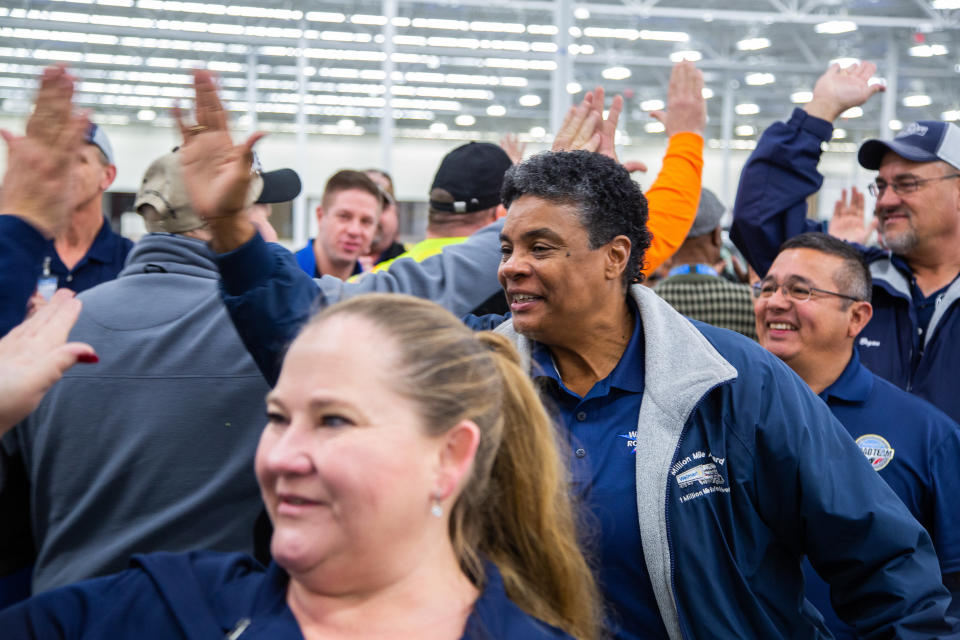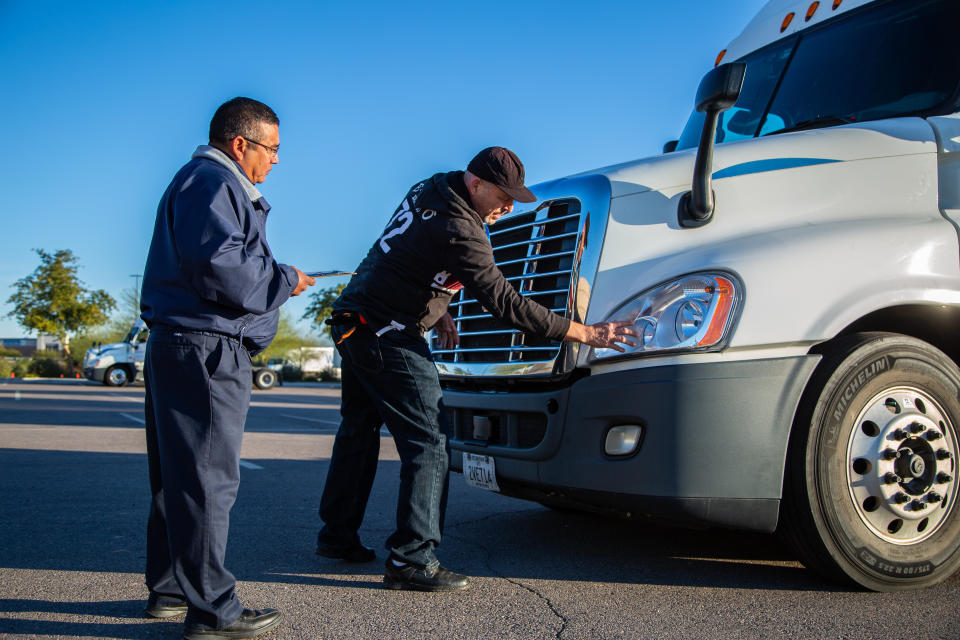How Walmart has successfully recruited truck drivers amid a labor shortage crisis
Walmart (WMT), the world's largest retailer, ramped up its hiring of truck drivers amid a driver shortage and is still in search of hundreds more.
In 2018, Walmart hired around 1,400 new drivers, up from 922 in 2017. Since August, the big-box retailer added about 694 drivers in net fleet growth, a number which includes the turnover that's coming mostly from retiring drivers.
"We have a commensurate amount of demand and freight to move. And so, we've seen a need to grow our private fleet — that, we view as a competitive advantage, from a value perspective. We've been hiring a lot of drivers," said Tracy Rosser, a senior vice president of transportation and supply chain at Walmart.
The recruitment is occurring against a backdrop of a "truck driver shortage crisis," fueled by an aging workforce and high levels of turnover.

In direct response to the shortage, Walmart began aggressively hiring drivers this fall by offering $1,500 referral bonuses, using social media to reach the younger generation, shortening the application time from 73 days to 31 days, and changing the format of its hiring events resulting in a higher pass rate. Drivers still must have at least 30 months of experience and meet other stringent requirements.
"Safety is our priority. We are not going to adjust our minimum standards due to a tight labor market," Rosser said.
Right now, close to 1,000 drivers remain in the hiring pipeline, including 200 who will attend hiring events in January and 400 referrals the company is evaluating.
A first-year driver can expect to make $86,000 driving for Walmart, or the equivalent of $0.87 per mile. The retailer also offers quarterly safe driving bonuses, benefits, and doesn't make its drivers load or unload freight. They can also accrue up to 21 paid days of vacation.
For a retailer like Walmart, trucking is its lifeblood, with drivers hauling freight from distribution centers and vendors to service Walmart's 4,700 U.S. stores. Walmart's founder Sam Walton recognized the importance of the role that he frequently relied on drivers to be his eyes and ears for what's happening in stores. Current CEO Doug McMillon spent his first day at the helm in Brookhaven, Mississippi on a ride-along.
An economy that gives and takes
The strong economy has highlighted this driver shortage because there's a demand to move freight. That includes a retailer like Walmart, with the latest U.S comp stores sales growing 3.4% in the third quarter.
"Over the last 18 to 24 months, as the economy has picked up, and demand has picked up, what has happened is there hasn't been enough capacity — both trucks and drivers — and the issue is really drivers, to move this large amount of freight that has come into the marketplace," Rosser said.
Meanwhile, Rosser, a 30-year veteran in the transportation business, noted that the trucking industry had lost drivers to other fields as the economy improved in recent years.
"You've had more demand that's been placed into an economy that's got super low unemployment levels pulling drivers out of the driving industry, because the driving industry is not the most favorable job in terms of quality of life, time away from home, unpredictable schedules, sleeping in your truck, those types of things, and pay. It's really created a shortage within the driving industry," Rosser added.
Retention has become a significant issue for the industry as a whole. According to the American Trucking Association, large truckload carriers are seeing an average turnover rate of 96% this year, the highest levels since 2013. According to Rosser, Walmart holds an industry low turnover average that's typically in the upper single digits or low double-digits, ranging from 7% to 12%.

"I assessed a driver this past week that was a 37-year driver of an owner-operator who was tired of being gone three, four weeks at a time," said Eric Ramsdell, a Walmart driver based out of the Buckeye distribution center west of Phoenix, Arizona.
Walmart aims to offer predictable schedules so its drivers can have a family life. A Walmart driver can expect to work five days on the road and two days at home.
Ramsdell, a 43-year-old nicknamed "Peanut" for being the youngest driver at his distribution center until about three months ago, started driving a truck 21 years ago and joined Walmart 14 years ago. He spent 3.5 years applying to Walmart.
"Trucking has taken care of me very well," Ramsdell said. "It's not as dirty and bad of a job as you think it is. You sacrifice being gone four, five nights a week, but it's a good way to get into the industry and see America and get paid to do it."
Walmart operates a fleet of 6,500 tractors with close to 8,300 drivers. The average age of a Walmart driver is 55.
A new hiring format
Perhaps the most significant change to Walmart's recruitment efforts has been the change to the hiring event format.
In years past, drivers would fill out an application, meet the minimum qualifications, and come in for what some call informally a "one and done." At the hiring events in the past, the prospects would demonstrate a pre-trip, backing exercise, and road test. However, if the driver failed any part of the trial, they'd immediately have to stop the test and wait another year to try again.
With the new process, Walmart is now assessing drivers over three days at these hiring events. On their first day, the drivers demonstrate their skill set for a pre-trip, backing exercise, and road test.
"Other than immediate safety dangers, we allow them to finish those three things," Ramsdell said.

During the second day, Walmart demonstrates the protocol and expectations for its fleet.
"They take the knowledge we show on day 2 in the morning and apply it in the afternoon and the next day," Ramsdell said, "The change from Monday to Wednesday in the quality of pre-trips and quality of backing and driving tests is a 180."
As a result of this change, the pass rates have jumped.
"If we did a 'one and done,' 5% to 10% would pass. Now, after day three, we have a 90% to 95% pass rate."
To be sure, the three-day event is not a training school.
"We're taking the knowledge they have and reminding them how crucial it is to do these certain things," Ramsdell said, adding, "That same driver driving for 37 years told me he learned more in three days than he had in 37 years. I gave him a few pointers. It's amazing how a different point-of-view and giving constructive feedback goes a long way."
Alexis Neville, a 39-year-old woman, based in Palestine, Texas, joined during one of the hiring events this fall. She began her career at Walmart as a cashier before moving to a support manager role at a Supercenter.
"One of my duties was to unload the truck when no one else was available. One lady driver from the New Canaan location came in, and I'd be working my butt off, sweating getting her truck unloaded. She's there standing with her arms folded. After doing that three times, I said, 'I'm on the wrong side.'"
Neville earned a CDL four years ago and starting driving for another company before coming to Walmart in October. Driving for Walmart was always her goal.
"It was a struggle at first because the company I was with it was hard to get home. I had to threaten to quit to go home and check on my house," Neville said. "I had to keep reminding myself, 'I'm in this, paying my bills to get to Walmart."
Now she's home every Monday and Tuesday "like clockwork."
"I get paid to see the country. I've been to every state, and somebody else has paid for me to go."
—
Julia La Roche is a finance reporter at Yahoo Finance. Follow her on Twitter. Send tips to [email protected].
